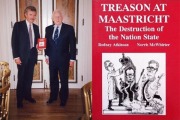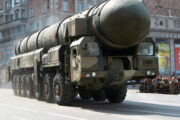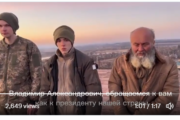BY SONYA JAY PORTER
According to Hansard of 11th December 2007, David Miliband, the then Foreign Minister, was asked to “give an undertaking that [the EGF] will never be allowed to operate on British soil”, but as Mr Dick-Erikson says, this undertaking was not given and in fact Mr Miliband confirmed that the force could do so, with the mere “consent” of the government.
It should be stressed here that the idea of a gendarmerie is as a military force designed for a state to use against its own people, not against foreign aggressors which is a totally alien concept to the British.
The Lisbon Treaty contained a “Solidarity Clause” (Article 222) which introduced substantial changes so that the European Gendarmerie Force can now “assist a Member State in its territory, at the request of its political authorities”. According to Hansard of 11th December 2007, David Miliband, the then Foreign Minister, was asked to “give an undertaking that [the EGF] will never be allowed to operate on British soil”, but as Mr Dick-Erikson says, this undertaking was not given and in fact Mr Miliband confirmed that the force could do so, with the mere “consent” of the government.
The organisation called the EUROGENDFOR, EGF, or more properly the European Gendarmerie Force, should be better known in Britain than it is, for its function is worrying and could affect this country in the future. The Eurogendfor is a combined police and militia force currently formed from six EU member states, designed along the lines of the French Gendarmerie which was established a few years ago to deal rapidly with any perceived threat of increasing civil unrest and to strengthen the EU Common Security and Defence Policy. It was originally set up by the European Union in September 2004 at the suggestion of the then French defence minister, has headquarters in Vicenza north eastern Italy with a core of 800-900 members ready to deploy within 30 days, and an additional 2,300 reinforcements available on standby.
At present, membership of this Gendarmerie Force is only open to EU countries which have a police force with military status and therefore does not include the United Kingdom whose system of policing is by consent and quite different from that which operates on the Continent. Nor does Germany take part as their constitution does not permit the use of military forces for police services.
To begin with, the Eurogendfor comprised forces from France, Portugal, The Netherlands, Italy and Spain but Poland and Lithuania became ‘partner countries’ in 2007 and 2009 respectively and Romania joined as a full member in 2008. In December 2011 Poland applied for full membership.
At the moment, the only other EU country which has the relevant police/military ability to join the Eurogendfor is Bulgaria but as and when the EU expands, Serbia, Albania, Georgia,the Ukraine and possibly Turkey could also be accepted as full members. However, there has been a recent suggestion made by the Netherlands Institute of International Relations (Clingendael) that the rules for inclusion might be relaxed, in which case all EU member states, including the UK, might join and, in theory, operate throughout the European Union.
The organisation is managed by its High Level Interdepartmental Committee (CIMIN) that consists of representatives from member states’ foreign and defence ministries and which decides on the inclusion of other countries in the Force and also on possible Eurogendfor missions. There is also a Presidency of CIMIN which lasts for one year, circulates around the various member states and for 2013 will be held by the General Commander of the Royal Dutch Marechaussee. The EGF has a motto: Lex paciferat, which means “law will bring peace”, (STRANGE THAT THEY THEREFORE NEED ARMED MILITARY POLICE! – ED.) and in 2005 a logo for both a flag and uniform badges was decided upon, consisting of a blue shield with central grenade on a vertical sword surrounded by the twelve stars of the EU flag. However, this was changed in 2007 when the stars were removed and the website’s address was altered from .eu to .org (http://www.eurogendfor.org/ ).
As Alfredo Vacca, Legal Advisor for the European Gendarmerie Force said in an e-mail to the writer dated 24th October 2012,
“Eurogendfor is at the disposal of the EU as well as of other International Organisations such as NATO, UN, OSCE and ad hoc coalitions but is not an EU asset.”
Eurogendfor was officially declared operational in 2006 but its status was not finally enshrined in law until 18th October 2007 in the Treaty of Velsen. According to Article 5 of this Treaty, the force may also be placed “at the disposal of…the UN, the Organisation for Security and Co-operation in Europe (OSCE), NATO and other international organisations or ad hoc coalitions” for various missions. Article 4 of the Treaty states that the EGF forces could be placed under either civilian authority or military command to perform security and public order missions, by supervising local police and including criminal investigation work. They could also conduct public surveillance, border policing and general intelligence work. They could also train instructors and police officers to international standards.
Torquil Dick-Erikson, a legal journalist who has lived in Rome for over 40 years and who has specialised in comparative criminal procedure, points out that Article 6.3 of the Treaty of Velsen allows the Eurogendfor to be deployed in another EU state with the simple agreement of that state.
Two months after the signing of that Treaty on 18th October 2007, the Lisbon Treaty was signed on 13th December. This contained a “Solidarity Clause” (Article 222) which introduced substantial changes so that the European Gendarmerie Force can now “assist a Member State in its territory, at the request of its political authorities”. According to Hansard of 11th December 2007, David Miliband, the then Foreign Minister, was asked to “give an undertaking that [the EGF] will never be allowed to operate on British soil”, but as Mr Dick-Erikson says, this undertaking was not given and in fact Mr Miliband confirmed that the force could do so, with the mere “consent” of the government.
Another worrying sign, pointed out by journalist Jason Groves writing in the Sunday Express a month before the signing of the Treaty of Velsen, was that the gendarmerie-type force had been in operation even before the Treaty had been signed. According to the Statewatch Analysis by Tim Schumacher already referenced, in 1998 during the military intervention in Bosnia, a similar force had been organised under NATO’s Stabilisation Force (SFOR) to fill the gap between the military and police and which had the powers to make arrests, to use firearms and to control civil unrest. This was followed in 1999 when a similar unit was sent to Kosovo under KFOR but here the force was also given “preventative and repressive resources for the suppression of unrest”. In 2000, seven years before the signing of the Treaty of Velsen, Statewatch points out that the European Council and all 27 EU States extended their “non-military crisis management” to include up to 5,800 officers in a Police Rapid Reaction Force consisting of police and gendarmerie units.
Since the signing of the Treaty of Velsen, the Eurogendfor has been involved in three operations. The first took place in Bosnia, starting in November 2007, shortly after the signing, when the force took charge of pre-existing Integrated Police Units (IPUs) and was sent to impose Western-style state and law enforcement. This lasted until October 2010. During January that year, the EGF was sent to Haiti to give aid following the recent devastating earthquake (the force was formed to deal with both man-made and natural disasters). This time it did not operate in support of NATO or even of the UN but as part of a European unit called EUCO and was largely supplied by an EU’s quasi-intelligence service named the EU Situation Centre (SITCEN).
But in the third operation, which began in April 2009 and is on-going, the Eurogendfor has formed a close association between the USA and NATO forces. According to Statewatch, the creation of an Afghan police organisation was entrusted to the force by NATO and since December of that year it has been setting up a large law enforcement body in Afghanistan which now consists of 160,000 officers. This new aspect of European foreign policy fits neatly with the basic concept of the EGF, which operates outside of parliamentary control and this can be expected to determine the nature of future European interventions.
Writing in the Clingendael Report of March 2009 under “Potential of the EUROGENDFOR”, Michiel de Weger suggests that it would be beneficial for the EGF to relax the rules and include more non-gendarmerie forces. Since the EGF already sets the common training standards of the national gendarmerie forces these additions could be made more professional and so contribute to closer EU cooperation in cross-border law enforcement. It should be stressed here that the idea of a gendarmerie is as a military force designed for a state to use against its own people, not against foreign aggressors which is a totally alien concept to the British.
The Clingendael Report gives another option for the EGF which has frightening potential: the training of gendarmerie or gendarmerie-type forces across the globe. The Solidarity Clause of the Lisbon Treaty makes it clear that the force will not only be able to control a population as a police, military and intelligence unit, but it will also be able to be deployed within the EU or outside. Following the Lisbon Treaty, its operations will be subject to very little democratic control by parliaments, and the EU parliament has no say at all since, as Alfredo Vacca the EUROGENDFOR’s Legal Advisor says, it is not an EU asset.
And as Michiel de Weger says, while there is an enormous pool of over 430,000 similar paramilitary troops which currently operate in EU countries alone, there are almost 2.5 million such personnel worldwide which could be trained by the EGF to undertake global actions. These could serve a dual purpose – for example, either to support a state riven by popular protest and civil unrest or to ensure the interests of the participating countries. There are now three EU controls over UK justice and home affairs
– the European Arrest Warrant which allows UK citizens to be arrested in this country (AND FOR OFFENCES WHICH MAY NOT BE CRIMES IN THE UK – ED.) and sent to foreign jails without bail while awaiting trial
– Europol, the European Intelligence Agency whose officers have diplomatic immunity
– and now the Euro-gendarmerie Force, a multinational police force with military status, which is now able to enter any EU member state, including the UK, at the request of the government and could also operate globally as a paramilitary force.
Is this what the UK public expected when it voted in 1975 to join the Common Market?
SONYA JAY PORTER is a Surrey-based freelance writer















